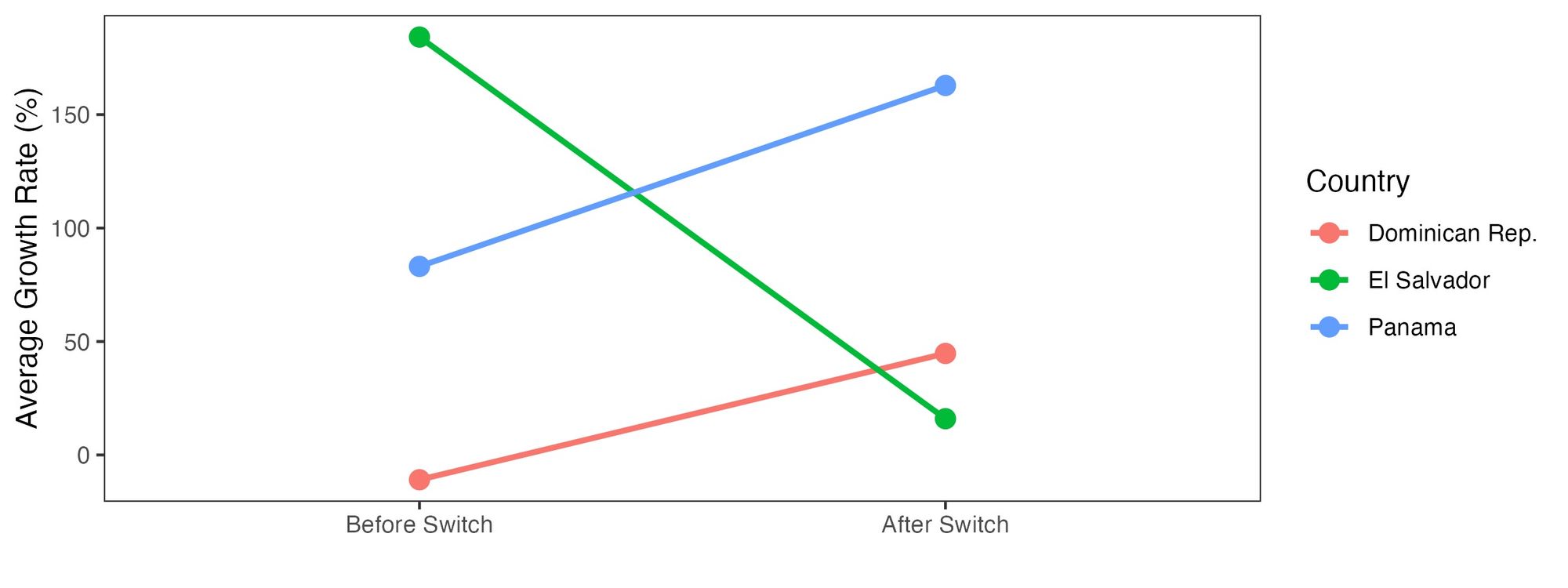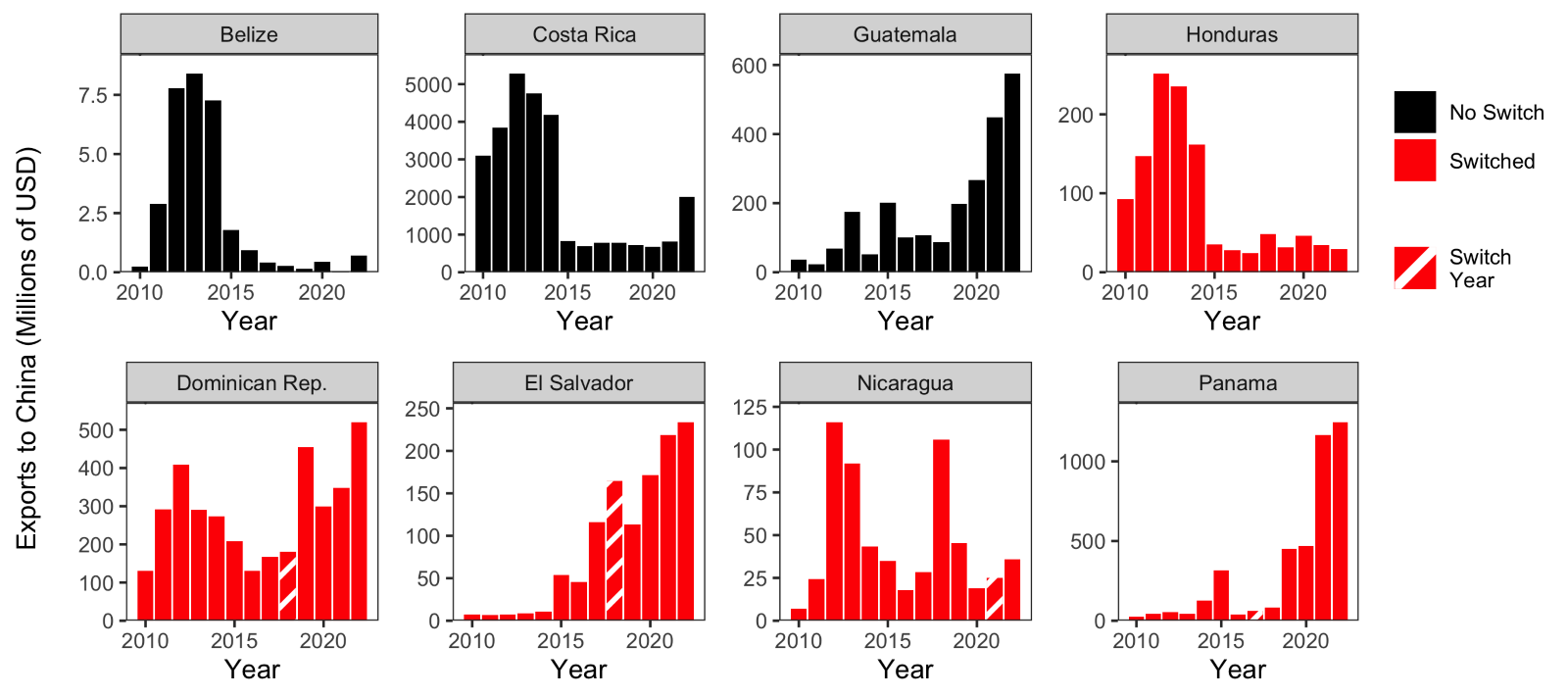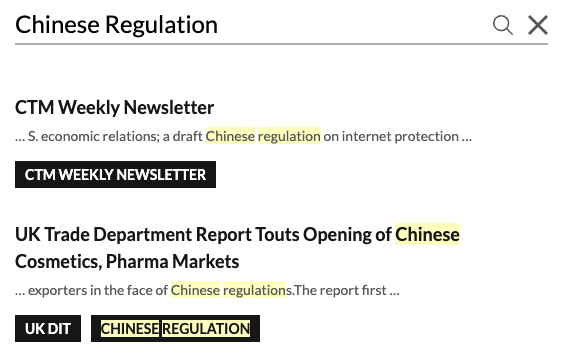Over the past few years, a handful of Central American and Caribbean countries have switched their political allegiance from Taiwan to Mainland China. In all likelihood, these governments assume there will be financial benefits from forging diplomatic ties with China, including through more trade and investment with China. A study of trade between China and the eight members of the Central American Integration System, five of which have switched their allegiance in recent years – Panama (2017), El Salvador (2018), the Dominican Republic (2018), Nicaragua (2021), and Honduras (2023) – provides some evidence to support this assumption, as these countries' exports to China tended to increase at a faster pace after diplomatic ties to China were established.
Five Central American countries switched their diplomatic ties from Taiwan to Mainland China in the past six years: Panama did it in 2017. One year later, El Salvador and the Dominican Republic followed suit. Nicaragua made the switch in 2021, and Honduras just did so this year.
Reflecting the geopolitical shift, the Central American Parliament (PARLACEN), the parliamentary body of the Central American Integration System (SICA), the two decade old institutional framework of regional integration in Central America, voted in August to replace Taipei with Beijing as a permanent observer. But Taiwan remains an observer at the SICA, which has eight members, including the five nations that recently switched political allegiance. The other three members are Belize, Costa Rica and Guatemala. Costa Rica established diplomatic ties with Beijing in 2007. Belize and Guatemala still have diplomatic ties with Taiwan.
By analyzing the trade data of the eight SICA members, a conclusion can be drawn that forging diplomatic ties with Beijing has helped the nations with boosting their exports to the Chinese market. On the other hand, imports from China to these nations and the investment inflows from China did not see a similar increase, suggesting that the impact may not have been as significant on these fronts as might have been expected.
Exports to China between 2015 and 2022
For the three nations that switched their diplomatic ties from Taiwan to Mainland China between 2015 and 2020, Panama (2017), El Salvador (2018), the Dominican Republic (2018), export data tends to show an increase that is correlated with their political transition. The trend can be seen in Figure 1, where the countries that switched their allegiance are shown as solid lines, with a marker indicating the year when they switched.

As shown in Figure 1, in the "switched" group, two nations, the Dominican Republic (in green) and Panama (in grey), witnessed a strong increase in exports to China soon after they switched diplomatic ties, which took place in 2018 and 2017, respectively. El Salvador (in purple) also saw a significant degree of increase in exports to China after its switch, although the growth was less than that of its neighbors.
This is evident when comparing the 3-year average growth rate before and after the country switched (excluding the switch year in both cases). As shown in Figure 2, both the Dominican Republic and Panama show a substantial increase in the growth rate after the switch year.

El Salvador, in contrast, had its growth rate decline after the switch. This is likely attributable to a large growth rate in 2015 (over 400%) and 2017 (154%) prior to the switch, as well as the impact of COVID 19 on exports from El Salvador after the switch. Even though the growth rate slowed down in later years, El Salvador's exports to China continued to increase, as illustrated in Figure 1 and Table I.

For the countries in the "switched" group that made the change more recently, Nicaragua (2021) and Honduras (2023), Nicaragua (blue line in Figure 1) had its exports go up by almost 50% in 2022, one year after it switched ties in 2021.
As for Honduras (red line in Figure 1), it just established ties with China this year, so it will take more time to determine if there is a trade impact.
For comparison purpose, data for three countries that did not switch in recent years, Belize, Costa Rica, and Guatemala, are shown in dashed lines in Figure 1 (even though Costa Rica switched in 2007, it is not included in the "switched group" because it occurred beyond the "recent period"). Only Guatemala (in orange in Figure 1) saw its exports to China grow steadily over the same period. Belize (in brown) and Costa Rica (in pink), on the other hand, saw their exports stay mostly flat during the period, until they picked up in 2022.
Based on these data, it seems reasonable to conclude that establishing diplomatic relations with mainland China did help these small countries with boosting exports to China. Increases in exports took place in all nations that switched allegiances before 2020, although the extent varies. For nations that switched after 2020, it may be too soon to see the full effect on trade.
Trade over the past decade
If we stretch the timeline and look at the trade data over the past decade, the story is slightly different but does not change the overall conclusion.

Export data between 2010 and 2022, as shown in Figure 3, indicates that two out of the five nations that switched allegiances in recent years, Panama and El Salvador, had their exports to China increase rapidly at approximately the same time they made the switch.
For the Dominican Republic, exports fluctuated in a significant way over the past decade but overall had an upward trend especially after the year of the switch.
Both Honduras and Nicaragua had significant exports to China in the early 2010s and saw their exports wane in recent years. Whether the shrinking exports incentivized the two nations to switch allegiances remains an open question, but it is evident that they hope to use this opportunity to boost their exports, as explained in the following paragraphs.
As for the countries that did not make the switch during the studied period, Guatemala had the most significant growth of exports to China, while Belize and Costa Rica both had a huge export drop around 2015 and 2016. The export slumps, however, were largely driven by the domestic economy of the exporters.
In the case of Costa Rica, which established diplomatic ties with China in 2007 and has had an FTA with China since 2011, the drop in 2015 is likely a reflection of a sharp decline in Costa Rica’s total electronics exports, as part of the "Intel effect," which was caused by a closure of chip manufacturer Intel’s Costa Rica plant. And for Belize, the export drop is driven by shrinking wood exports to China, combined with a fiscal deterioration which extended into 2016.
Imports from China between 2015 and 2022
Looking at trade in the opposite direction, China's exports to the eight countries, as shown in Figure 4 with detailed data in Table IV, grew in a more consistent way across the board. In general, imports from China picked up in 2020 when China expanded its exports to most nations as the COVID-19 crisis spread globally. In other words, there is no evidence that establishing diplomatic relations with China results in a significant change in imports from China beyond what it otherwise would have been. In other words, the change of diplomatic relations does not seem to have had an impact on how much China sells to these countries.
The only outlier here, Panama, had the peak of its imports from China in 2012, when total imports reached US$15 billion, five years before it switched allegiances. Imports then declined starting in 2013 until they slowly picked up again after 2017, although they never reached the previous level.

Trade negotiations
Soon after establishing political ties with the Chinese government, both Nicaragua and Honduras kicked off trade talks with Beijing. For Nicaragua, it started a trade negotiation with China last year, concluded an early harvest agreement in May, under which 60 categories of goods, including food, clothing and cables would be tariff-free when shipping to China. In August, the two nations signed a free trade agreement, which is now going through domestic procedures before entering into force.
Similarly, Honduras, which established diplomatic ties with China in March, already stands ready for trade talks, and has already received approval for its aquatic products (including white shrimp), bananas, and coffee beans to be exported to China.
El Salvador, which created official relations with China in 2018, is also engaging with China on trade talks. Last November, El Salvadoran President Nayib Bukele tweeted (link in Spanish) that his government “will sign a free trade agreement with China."
It took El Salvador several years to sort through some legal issues with Taiwan, which delayed its trade talks with Mainland China. El Salvador broke off official ties with Taiwan in 2018 but they had a trade agreement since 2007. As a result of the termination of diplomatic relations with Taiwan, the El Salvador government was set to cancel the benefits of the treaty by 2019, but the decision was challenged in a domestic legal fight. A final ruling (link in Spanish) issued by the Supreme Court of Justice sustained the government decision.
The overall impact of these recent sectoral negotiations and eventual comprehensive agreements, if concluded, on trade remains to be seen.
Not all trade negotiations will lead to a concluded agreement. For instance, Panama started trade negotiations with Beijing in 2018, one year after the two nations established diplomatic relations, but the negotiations have been stalled since 2019. However, the stalled trade negotiations have not stopped Panama from increasing exports to China.
Investment
In contrast to trade, Chinese outward foreign investment in Table II, based on data (link in Chinese) provided by China's Ministry of Commerce and National Bureau of Statistics, shows no correlation between these countries' political stances and China's outward FDI stock in these nations over the period from 2013 and 2021.

For instance, Chinese FDI in El Salvador was minimal and showed no change when the country switched allegiances in 2018. Similarly, while the Chinese FDI in the Dominican Republic fluctuated, the overall amount of FDI remained low. In comparison, Panama saw Chinese FDI grow steadily since 2018, one year after it changed political ties.
Among non-switching nations, Costa Rica saw Chinese FDI grow rapidly since 2017. FDI in Belize remained low throughout the years in the study. (The reported value of US$447.92 million for Belize in 2021 is questionable, because of a discrepancy between the FDI stock and flow data.) On the other hand, Guatemala saw fluctuating investment from China over the same period.
Conclusion
The trade data between China and these eight Central America/Caribbean countries provides evidence for, in most cases, the theory that establishing diplomatic relations with Mainland China does help these countries with expanding their exports. Based on the data available, increases in exports were witnessed in all nations that switched allegiances before 2020, while the effect on trade with the nations that switched in more recent years will need more time to assess.
This trend is less obvious when measuring imports from China. There is also not enough data to show a statistically significant correlation between establishing diplomatic relations with Mainland China and receiving a large amount of investment from the nation.
Annexes:



